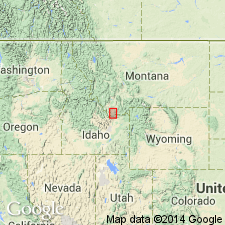
- Usage in publication:
-
- Monida Formation
- Modifications:
-
- Named
- Dominant lithology:
-
- Sandstone
- AAPG geologic province:
-
- Montana folded belt
Summary:
Name applied to sandstone-dominated strata near Monida, MT, in the Montana folded belt province that are contiguous with conglomeratic beds of the Beaverhead Formation. The change from predominant conglomerate (Beaverhead) to predominant sandstone (Monida) takes place approximately halfway between Snowline and Monida, MT. Divided into lower sandstone member of Beaverhead and upper sandstone member (equivalent to [upper sandstone member] of Beaverhead). Thickness of lower member is 2,300 ft; thickness of upper member not given. Both Monida and Beaverhead unconformably overlie units that range in age from Mississippian Madison Group through Lower Cretaceous Aspen Formation that were deformed in early Laramide time. Youngest Monida and Beaverhead strata unconformably overlain by Eocene and Oligocene nonmarine sedimentary and volcanic rocks. Recognized on northern flanks of Tendoy Range and southern flanks of Snowcrest Range. Is of Late Cretaceous to Paleocene (or Campanian to Thanetian) age. Major source area was in west-central WY and southwest MT and easternmost ID.
Source: GNU records (USGS DDS-6; Denver GNULEX).
For more information, please contact Nancy Stamm, Geologic Names Committee Secretary.
Asterisk (*) indicates published by U.S. Geological Survey authors.
"No current usage" (†) implies that a name has been abandoned or has fallen into disuse. Former usage and, if known, replacement name given in parentheses ( ).
Slash (/) indicates name conflicts with nomenclatural guidelines (CSN, 1933; ACSN, 1961, 1970; NACSN, 1983, 2005, 2021). May be explained within brackets ([ ]).

